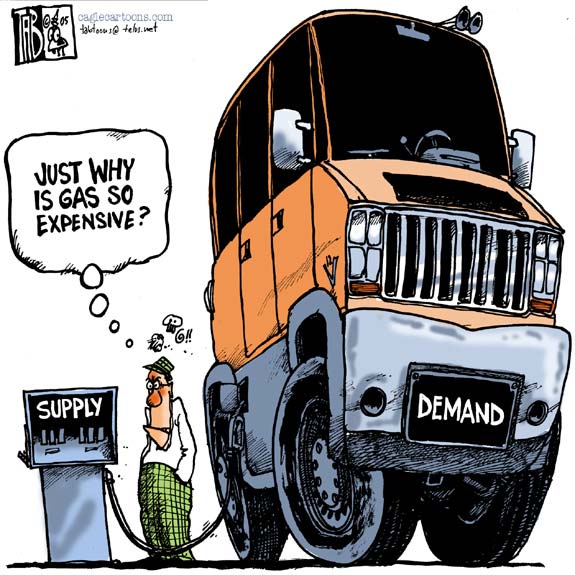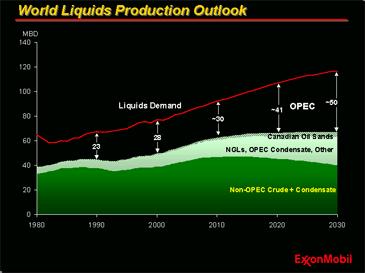|
ECONOMICS |
|
OIL STATS
Oil, the Energy Crunch??? National Geographic, The End of Cheap Oil,6/04, p. 97
Oil, the Energy Crunch??? Gasoline taxes average 43¢/gal Production is ½ of 1970’s. Consumption 02 (millions of barrels: US
7,191, 3.2% increase 04, predicted 1.7 for 05 Business SUV deduction of up to $10,000 In 1981 oil was above $70/barrel in 2004 dollars, by the mid
80s it dropped to less than $25/barrel. The new deep-water Gulf filed has an estimated 25B barrels,
another almost as large field is in the Artic National Wildlife Refuge in Canadian
shale oil cover 15,000 sq miles, equals 1.6 trillion barrels, but yields only 1 barrel for every two town of deposit. Gasoline costs $1.57/ gal
= .43 tax, .75 crude oil, .24 refining, 15 distribution & marketing. Additional costs: $.80 traffic congestion (time and wasted fuel), pollution (effects
upon respiratory health), .12 leaky oil from refineries & distribution centers.
National Geographic, The End of Cheap Oil,6/04, p. 97. $225 billion of the Profit margin up 80% in
04 from that of 99 Refiners made $0.228 in
99/gal of gasoline, in 04 $0.408 Increase in oil price from
03 costs the 9% of GDP spent on oil. MYSTERY TO BE UNFOLDED: What happened to the money from the privatization of USSR’s resources? If the resources were sold at fair market value and the funds were paid to the state, say over 20 year
period, there would be no need for tax for at least the next 40 years. Where
did the funds go??? What about the factories, state lands, stores, etc? Where did the funds go? If you have an
article answering this mystery, contact California Skeptics @ *@skeptically.org Personal effects of oil on JK’s finances In January of 04, I became fully invested in the
market. The economic upturn should have continued, for interest rates were low
and the previous quarters growth in GDP was approximately 8% (the announced the final, adjusted figure months later can differ
by as much as 2 percent). However, like a balloon the market deflated, only to
regain it former position a month after Bush’s election. Oil pricked the
balloon. Congress had some year before drafted an exception to the fuel economy
law, they lumped SUVs with pickups as excluded. With 25% or so of the vehicles
on the road getting half the mileage of my Honda, the consumption of oil rose by 3.2% in 04 (and is expected to go up another
1.7%). Much of that is do to the economic upturn.
But if they only excluded vehicles with a commercial license our oil consumption would be down by around 10%. Since spending on oil doesn’t translate into jobs, with Americans having that
much more pocket money, our stock markets would have broke the 02 high, and I would have over doubled my money—for I
positioned myself for just such a move. By December 3rd, I was down
10%; what a difference gas-guzzlers made. |
|
Businessweek Online NOVEMBER 15, 2004
at businessweek.com Crude Lessons About Oil
The problem is that the
world can't just switch from one to the other. "Heavy, sour" oil is more complex and costly to convert into useful products
such as gasoline and heating oil. And much of the world's refining capacity, particularly in Asia, simply can't process it.
"There's no shortage of crude oil today," says Thomas D. O'Malley, chairman of Premcor Inc. (PCO ), a refiner based in Old Greenwich, Conn. "There is a shortage of light sweet." this is why I love g. w. bushwack. It aint what we have but what we could have had. for more on gw go to http://skeptically.org/curpol/id11.html Don‘t Hold Your Breath for Hydrogen If hydrogen is the fuel of the future, the future may be a long time coming. An American Physical Society
panel reports that vast improvements in hydrogen production, storage, and use are needed to meet President Bush’s
goal of having commercially viable hydrogen cars on the road by 2020. The key challenges: Production. Hydrogen
produced by converting coal or by splitting water with electricity costs four times as much as gasoline. The coal
process will require better catalysts to purity the hydrogen and technologies to capture the carbon dioxide released during processing.
Electrolysis will require cheaper electricity and a more efficient way to separate hydrogen from water. Storage. A practical hydrogen
tank should power a vehicle for 300 miles and take less than 5 minutes to fill; current technology does not come close. Pressurized
gas tanks do not hold enough fuel. Liquid tanks must be cooled to —450 degrees Fahrenheit, which eats up energy; after a few days the hydrogen begins to evaporate. Solid tanks are still in the early
stages of development. Use. The cost of fuel cells
must drop to at least one-fourth of their current price ($3,000 per kilowatt generated) to compete with gasoline internal-combustion
engines. Cost reductions depend on finding an improved electricity generating membrane, one that runs efficiently
and reliably and does not need the expensive platinum now used. —Zach
Zorich Another
major problem is that of the catalyst which is a major recurring expense. Tiny
amounts of impurities will poison the catalyst; i.e., bond to the platinum and thus prevent stopping the reaction which
liberates hydrogen.--jk Bush requested a $75,000 SUV tax break in 03, and got a $!00,000 for the least fuel-efficient vehicles. If incentives had continued for oil efficiency, oil would still be under $40/ barrel. This not only means that Americans have less money for trinkets and medical treatments,
but that the poorest nations have less for basic sanitation, medical clinics, and education, and their citizens have less
for necessities. Why there are so many pigs on the road:
for the Union of Concerned Scientists’ article on the SUV tax break. For the
best account of the Federal Reserve (http://www.freedocumentaries.org/film.php?id=214). One cannot understand |

